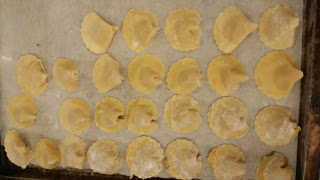Chef brought his decades of experience, his fundamentals of tough training through a 4-year apprenticeship in Austria, his decisions to come to Canada and take his chances ... and more than a few stories about chefs he's worked with, some of whom were just weird.
So, our students got an earful AND training in the fundamentals of pastry. Starting with just four ingredients (water, butter and flour, followed by a few eggs) they learn to make choux paste ... and then work magic with it!
Take a few basic things and learn to play ... treat the results with heat, then tenderly fill the little balls up to make profiteroles,

 injected with Chantilly cream lightly touched with flavour. After making them, letting them cool and counting them, we had about 117 profiteroles. Every one of them got filled
injected with Chantilly cream lightly touched with flavour. After making them, letting them cool and counting them, we had about 117 profiteroles. Every one of them got filled 


 and, by the end of lunchtime there was not a single profiterole left.
and, by the end of lunchtime there was not a single profiterole left.Most everyone looked a bit glazed over.
Check the concentration. Enjoy the result!
Then, just as a second tease to the palette AND the tongue, we made Black Forest Cake.
Black Forest Cake is a traditional dessert. It has room for little variation if done according to tradition, and in our kitchen this time we discouraged experimentation ... learn the basics, learn the fundamentals, appreciate the traditions ... THEN inject yourself into the creative process AFTER you've got the basics down pat. That is my rule, and Chef Herbst reinforced it with every example.
First, make a plain and very good chocolate cake in a springform pan. Make it slightly higher than usual, if possible, so the layers come out right and very visible.
Cool the cake overnight: A cake even slightly warm cannot be dressed with icing or any topping.
Today (Chef Herbst's third day with us) was all about the final finishing and decoration. New skills learnt included the use of a baker's comb and skillful manipulation of the piping bag. Start by taking the cooled cake and cut it in half laterally, then fill the inside cut with cherries in heavy syrup.
Then replace the top slice
Then ... Pride! check it out!!







Well done all.
And at the end, student chef Mariam offered Chef Herbst a thank-you on behalf of everyone.
There was no cake left...none at all.














